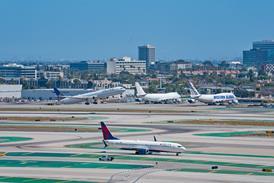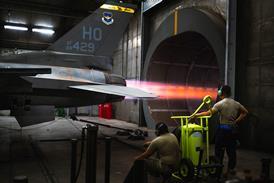STEFANO SALA with others at ROLAND BERGER STRATEGY CONSULTANTS
With Europe searching for a solution to a mounting crisis over delays, now could be the time to look at new pricing mechanisms for air traffic control
As delays continue to mount in Europe's congested skies, there is now talk of the need for radical reform, not least in the way that the region handles air traffic control (ATC). But that begs a simple question: what exactly is the purpose of ATC? Until relatively recently, the answer seemed obvious: ATC's task was to focus almost exclusively on air safety. But as congestion grows, so ATC has developed its other role as service provider, allocating increasingly scarce airspace resources. And just as that role has come to the fore, so too have its shortcomings become apparent. So is now perhaps the time to think the previously unthinkable and look at demand-driven pricing for ATC slots?
Clearly, the present structure was established at a time when traffic levels were low and allocation of resources was hardly at issue. It was also a time when, for all the international co-operation initiatives led by organisations such as Eurocontrol, national sovereignty over airspace was taken for granted. In such circumstances, the system's inherent allocative inefficiency was tolerable. In today's commercial single European air market, an inefficient system of resource allocation acts as a largely hidden tax on the region's aviation.
So how much do delays really cost? The direct costs are fairly clear, but there are also indirect penalties for airspace users which are less obvious. Only now are the real shortcomings in ATC service provision and their impact on delays being quantified accurately. Although ATC charges already represent a significant part of airline operating costs, traffic delays potentially have an even greater effect on profitability. They not only have an impact on service standards and cost structures (through wasted fuel and poor productivity) but also ultimately on the quality of the network product.
Current delay reporting understates the fraction of delays for which ATC is responsible. A significant proportion of Europe's delays are categorised as "reactionary" or "rotational" - resulting from the knock-on effects of earlier delays. For a truer picture these reactionary delays should be attributed to the cause of the original delay. Reallocating delay codes in this way raises the proportion of ATC-related delays from 27% to 40%.
Clarity about the delays also allows airline improvement initiatives to focus on the true causes of punctuality problems and avoids the situation where, for example, an improvement in the ramp handling performance can paradoxically weaken the pressure the airline brings to bear for ATC improvements.
One approach to improving punctuality has been simply to increase block times. Although superficially tempting, it carries significant hidden costs. In the short term, not only is asset utilisation lower as aircraft fly fewer sectors per day, but longer "official" journey times compared to the schedules of competing carriers mean less attractive positioning on computer reservation systems, and lower market share. In the longer term, especially within Europe with its well-developed road and high-speed rail infrastructure, airlines face the danger that would-be passengers will find artificially inflated short-haul flight times unattractive compared with alternatives.
What the users want
So what do airlines really want from ATC? First, a reduction in delay variability - it has been said that "if you can be notoriously late, you can also be notoriously on-time" and reduced delay variability is only one step away from being on time. Second, a reduction in delays. And finally, a move by ATC to a "service provider" orientation. The first two of these are related to technology. The last, however, is organisational. On that point, much has been made of proposals to raise capacity through rationalisation of upper airspace. A key aim of the Single European Sky initiative being pursued by the European Commission (EC) is to bring upper airspace under a single provider in order to help improve efficiency and so raise capacity. Yet, while this is a worthy aim, there is a need to recognise a couple of fundamental issues: Europe has a shortage of "gross" capacity, and is inefficient in allocating capacity in conditions of scarcity. Organisational change and technological developments should increase capacity, but these steps are only preconditions for fundamental ATC reform.
There will always be situations where airspace demand exceeds supply, and any sustainable reform must include an appropriate and efficient allocation mechanism, as well as a means by which the customer airlines can incentivise ATC to provide better service. Traditional cost-recovery pricing may well have been suited to an environment where efficient allocation of scarce resources is handled separately or is simply not important - such as was the case with European airspace when the present arrangements came into being. But cost-based pricing does not itself drive the efficient allocation of resources. In fact it tends to do the opposite. If the price of flying through a sector is calculated by taking the ATC costs and dividing them by the total number of flights passing through, then it should theoretically follow that the busier the sector the lower the per-flight charge. Logically, the most congested sectors should therefore be cheaper to fly. That this has not itself given rise to a further worsening of congestion is probably due to the fact that airline dispatchers and crews do factor in the indirect costs of congestion in their routing decisions.
The solution could be to adopt yield management techniques for pricing slots according to demand. A move away from pure cost-recovery pricing would not only enable ATC providers to steer demand using pricing as a tool, but would also reward an increase in capacity with a boost in revenues. Of course, for such a step to be successful, the ATC provider or its shareholders must be able to benefit from those increased revenues. That is true regardless of ownership. The ATC provider could be constituted as a for-profit public-private partnership, or as a not-for-profit trust. It is important to note that the proposed change in pricing structure does not necessitate ATC privatisation.
To understand how this could work, consider a typical distribution of traffic on an average ATC sector. Traffic is likely to show at least a couple of sharp peaks at the beginning and end of the business day. Congestion and delays will worsen as traffic approaches and ultimately exceeds the theoretical maximum capacity of the sector. Aircraft may be placed in holding patterns or held before take-off.
Clearly, an increase in the capacity of the sector has the effect of "raising the bar" and reducing congestion. What, though, would be the effect of peak-based pricing? Some airlines are likely to react to higher prices for slots during the peak periods by rescheduling their flights to spread the peaks, thus reducing congestion. A further conceivable effect, on routes which are currently served by frequent "shuttle" services, is a migration over time to fewer frequencies but larger aircraft types. In either case, demand at peak times is eased.
In the case of an ATC sector neighbouring a major airport, there are likely to be several daily peaks corresponding to the waves at the hub. Peak-based pricing, (if not worsening congestion), may lead the hub airline to reduce the peaks by spreading its flights over an increased number of waves. It is true that optimised scheduling can deliver significant punctuality and robustness advantages, as demonstrated at the Vienna hub in a project led by Roland Berger Consultants. But success still remains ultimately dependent on how closely ATC and the airlines work together.
Setting the price
The next issue centres on how prices could be set in such an environment to achieve best utilisation of resources. An auction is perhaps the most efficient approach, where airspace users bid for en route slots. Based on the auction results, these airways would be assigned over a time period comparable with the current strategic planning horizons of Eurocontrol's central flow management unit. It would then be dynamically managed as close as possible to the day of operations to take account of other causes of delay.
Such a pricing mechanism could be used to steer the demand and balance the load, attracting flights in periods of available capacity and deterring them during peak times - or rather diverting them onto other less popular routings.
Airlines might initially be tempted to view such a mechanism negatively. Some en route charges would indeed be higher and ATC costs would increasingly become a determining factor in airline decision making. But the improved capacity allocation should in the medium term improve reliability and cut delays. Above all, it would remove a key source of market inefficiency. There would be far-reaching implications for all the players in this brave new world, which in effect creates an open marketplace for air routes. This liberalisation should bring with it the same scope for commercial innovation it has in other industries, such as electricity supply and telecommunications.
So much for a single sector taken in isolation, but what of the relationship between different ATC sectors or providers under such a modified pricing scenario? Take the simplified example of a route which passes through four ATC sectors, all of which have differing capacities. If the first sector reaches saturation, then the entire "pipeline" is effectively saturated. The other three sectors are deprived of additional traffic (and revenue) by the bottleneck in the first sector regardless of whether they have spare capacity. Under the circumstances, the saturated sector would be under pressure to increase its capacity, either from the other sectors suffering from the bottleneck or from the need to increase its own revenues.
It is worth noting that this mechanism does not make any assumptions about ATC providers competing with each other, or even about the form of organisation of the upper airspace. Local ATC providers would be responsible for setting their own charges -Êa devolution of responsibility very much in accordance with the European Union's oft-expressed and fundamental principle of subsidiarity (ie, that national rules apply unless overriden by European law).
The approach brings some other benefits. By reducing congestion, it should cut down on unnecessary aircraft fuel consumption and thus help remove a little of air travel's negative environmental impact. Contrary to some suggestions, a move away from the existing pricing structure does not imply a reduction in safety, but rather the opposite. A reduction in congestion, in fact, should lower the likelihood of accidents. It is sometimes suggested that commercial ATC providers whose profits were linked to the number of aircraft movements they handled would be inclined to erode safety standards in the interests of increased profit, or conversely to increase charges to take advantage of geographical monopolies. Airspace is normally viewed as a natural monopoly, and ATC providers would thus have to be subject to a regulatory regime, not only to ensure that safety standards were rigorously upheld but also to avoid monopoly abuse. The regulatory regime for charges could vary from a responsible authority which would approve all rate applications, through to a hands-off clearing-house with an appeals board.
Momentum builds
The momentum for reform in European ATC continues to build. However, existing proposals tend to focus on capacity improvements, through technological and organisational change, while neglecting another essential element - the need to establish a "normal" supplier/customer relationship with the airspace users, in which price is related to quality of service and to demand. Supply-side changes, which are designed to raise efficiency and increase capacity, may be both valuable and necessary, but they are no substitute for addressing the true underlying problem. That is the absence of any efficient slot allocation mechanism.
Not even the EC's plans to bring European upper airspace under a single provider would address this fundamental issue directly. It is high time now to open up a debate on practical and sustainable demand-steering mechanisms - an issue that is not necessarily touched by the current debate over the nature and number of European ATC agencies. Failure to address pricing in any forthcoming restructuring of the sector will represent not only a missed opportunity, but as an ongoing brake on the development of European air transport.
Source: Airline Business























